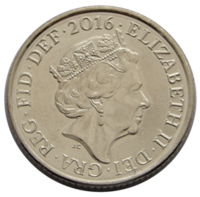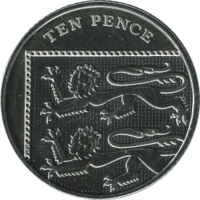Ten pence (British coin)
| United Kingdom | |
| Value | 0.10 pound sterling |
|---|---|
| Mass | (1968–1992) 11.31 g (1992–present) 6.5 g |
| Diameter | (1968–1992) 28.5 mm (1992–present) 24.5 mm |
| Thickness | (Cupro-nickel) 1.85 mm (Steel) 2.05 mm |
| Edge | Milled |
| Composition |
Cupro-nickel (1971–2012) Nickel-plated steel (2012–) |
| Years of minting | 1968–present |
| Obverse | |
 |
|
| Design | Queen Elizabeth II |
| Designer | Jody Clark |
| Design date | 2015 |
| Reverse | |
 |
|
| Design | Segment of the Royal Shield |
| Designer | Matthew Dent |
| Design date | 2008 |
The British decimal ten pence (10p) coin – often pronounced ten pee – is a unit of currency equalling ten one-hundredths of a pound sterling. Its obverse has featured the profile of Queen Elizabeth II since the coin's introduction in 1968, replacing the two shilling coin in preparation for decimalisation in 1971. Four different portraits of the Queen have been used on the coin, with the latest design by Jody Clark being introduced in 2015. The second and current reverse, featuring a segment of the Royal Shield, was introduced in 2008.
Five pence and ten pence coins are legal tender only up to the sum of £5; this means that it is permissible to refuse payment of sums greater than this amount in 5p and 10p coins in order to settle a debt.
The ten pence coin was originally minted from cupro-nickel (75% Cu, 25% Ni), but since 2012 it has been minted in nickel-plated steel due to the increasing price of metal. From January 2013 the Royal Mint began a programme to gradually remove the previous cupro-nickel coins from circulation with replacement by the nickel-plated steel versions.
As of March 2014 there were an estimated 1,631 million 10p coins in circulation with an estimated face value of £163.080 million.
To date, three different obverses have been used. In all cases, the inscription till 2015 was ELIZABETH II D.G.REG.F.D. 2013, where 2013 is replaced by the year of minting. In the original design both sides of the coin are encircled by dots, a common feature on coins, known as beading.
As with all new decimal currency, until 1984 the portrait of Queen Elizabeth II by Arnold Machin appeared on the obverse, in which the Queen wears the 'Girls of Great Britain and Ireland' Tiara.
...
Wikipedia
